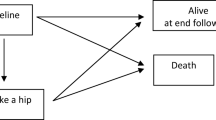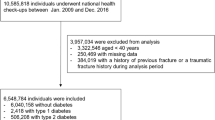Abstract
Summary
There is scarce data on the association between early stages of type 2 diabetes and fracture risk. We report a 20 % excess risk of hip fracture in the first years following disease onset compared to matched non-diabetic patients.
Introduction
Type 2 diabetes mellitus (T2DM) is a chronic disease that affects several target organs. Data on the association between T2DM and osteoporotic fractures is controversial. We estimated risk of hip fracture in newly diagnosed T2DM patients, compared to matched non-diabetic peers.
Methods
We conducted a population-based parallel cohort study using data from the Sistema d’Informació per al Desenvolupament de la Investigació en Atenció Primària (SIDIAP) database. Participants were all newly diagnosed T2DM patients registered in SIDIAP in 2006–2011 (T2DM cohort). Up to two diabetes-free controls were matched to each T2DM participant on age, gender, and primary care practice. Main outcome was incident hip fracture in 2006–2011, ascertained using the tenth edition of the International Classification of Diseases (ICD-10) codes. We used Fine and Gray survival modelling to estimate risk of hip fracture according to T2DM status, accounting for competing risk of death. Multivariate models were adjusted for body mass index, previous fracture, and use of oral corticosteroids.
Results
During the study period (median follow-up 2.63 years), 444/58,483 diabetic patients sustained a hip fracture (incidence rate 2.7/1,000 person-years) compared to 776/113,448 matched controls (2.4/1,000). This is equivalent to an unadjusted (age- and gender-matched) subhazard ratio (SHR) 1.11 [0.99–1.24], and adjusted SHR 1.20 [1.06–1.35]. The adjusted SHR for major osteoporotic and any osteoporotic fractures were 0.95 [0.89–1.01] and 0.97 [0.92–1.02].
Conclusions
Newly diagnosed T2DM patients are at a 20 % increased risk of hip fracture even in early stages of disease, but no for all fractures. More data is needed on the causes for an increased fracture risk in T2DM patients as well as on the predictors of osteoporotic fractures among these patients.


Similar content being viewed by others
References
Soriguer F, Goday A, Bosch-Comas A et al (2012) Prevalence of diabetes mellitus and impaired glucose regulation in Spain: the Di@bet.es Study. Diabetologia 55:88–93
Curiel MD, García J, Carrasco J (2001) Prevalencia de osteoporosis determinada por densitometría en la población femenina española. Med Clin (Barc) 116:86–88
De Liefde II, van der Klift M, de Laet CEDH, van Daele PL, Hofman A, Pols HAP (2005) Bone mineral density and fracture risk in type-2 diabetes mellitus: the Rotterdam Study. Osteoporos Int 16:1713–1720
Vestergaard P (2007) Discrepancies in bone mineral density and fracture risk in patients with type 1 and type 2 diabetes—a meta-analysis. Osteoporos Int 18:427–444
Janghorbani M, Van Dam RM, Willett WC, Hu FB (2007) Systematic review of type 1 and type 2 diabetes mellitus and risk of fracture. Am J Epidemiol 166:495–505
Ahmed LA, Joakimsen RM, Berntsen GK, Fønnebø V, Schirmer H (2006) Diabetes mellitus and the risk of non-vertebral fractures: the Tromsø study. Osteoporos Int 17:495–500
Forsén L, Meyer HE, Midthjell K, Edna TH (1999) Diabetes mellitus and the incidence of hip fracture: results from the Nord-Trøndelag Health Survey. Diabetologia 42:920–925
Blakytny R, Spraul M, Jude EB (2011) Review: The diabetic bone: a cellular and molecular perspective. Int J Low Extrem Wounds 10:16–32
Martínez-Laguna D, Nogués-Solán X, Díez-Pérez A, Soria-Castro A, Carbonell-Abella C, Arias-Moliz I, Estrada-Laza P, Prieto-Alhambra D (2013) Riesgo de fractura asociado a los estadios previos al diagnóstico de diabetes mellitus tipo 2: estudio de casos-controles anidados (cohorte DIAFOS). Rev Osteoporos Metab Min 02:73–78
Schwartz AV, Vittinghoff E, Sellmeyer DE et al (2008) Diabetes-related complications, glycemic control, and falls in older adults. Diabetes Care 31:391–396
Kanazawa I, Yamaguchi T, Yamamoto M, Yamauchi M, Yano S, Sugimoto T (2009) Relationships between serum adiponectin levels versus bone mineral density, bone metabolic markers, and vertebral fractures in type 2 diabetes mellitus. Eur J Endocrinol 160:265–273
Kahn SE, Haffner SM, Heise M et al (2006) Glycemic durability of rosiglitazone, metformin, or glyburide monotherapy. N Engl J Med 355:2427–2443
Home PD, Jones NP, Pocock SJ, Beck-Nielsen H, Gomis R, Hanefeld M, Komajda M, Curtis P (2007) Rosiglitazone RECORD study: glucose control outcomes at 18 months. Diabet Med 24:626–634
Meier C, Kraenzlin ME, Bodmer M, Jick SS, Jick H, Meier CR (2008) Use of thiazolidinediones and fracture risk. Arch Intern Med 168:820–825
García-Gil MDM, Hermosilla E, Prieto-Alhambra D, Fina F, Rosell M, Ramos R, Rodriguez J, Williams T, Van Staa T, Bolíbar B (2011) Construction and validation of a scoring system for the selection of high-quality data in a Spanish population primary care database (SIDIAP). Inform Prim Care 19:135–145
Vinagre I, Mata-Cases M, Hermosilla E, Morros R, Fina F, Rosell M, Castell C, Franch-Nadal J, Bolíbar B, Mauricio D (2012) Control of glycemia and cardiovascular risk factors in patients with type 2 diabetes in primary care in Catalonia (Spain). Diabetes Care 35:774–779
Prieto-Alhambra D, Premaor MO, Fina Avilés F, Hermosilla E, Martinez-Laguna D, Carbonell-Abella C, Nogués X, Compston JE, Díez-Pérez A (2012) The association between fracture and obesity is site-dependent: a population-based study in postmenopausal women. J Bone Miner Res 27:294–300
Premaor MO, Compston JE, Fina Avilés F, Pagès-Castellà A, Nogués X, Díez-Pérez A, Prieto-Alhambra D (2013) The association between fracture site and obesity in men: a population-based cohort study. J Bone Miner Res 28:1771–1777
Prieto-Alhambra D, Premaor MO, Avilés FF, Castro AS, Javaid MK, Nogués X, Arden NK, Cooper C, Compston JE, Diez-Perez A (2014) Relationship between mortality and BMI after fracture: a population-based study of men and women aged ≥40 years. J Bone Miner Res 29:1737–1744
Pages-Castella A, Carbonell-Abella C, Aviles FF, Alzamora M, Baena-Diez JM, Laguna DM, Nogues X, Diez-Perez A, Prieto-Alhambra D (2012) “Burden of osteoporotic fractures in primary health care in Catalonia (Spain): a population-based study”. BMC Musculoskelet Disord 13:79
Fine JP, Gray RJ (1999) A proportional hazards model for the subdistribution of a competing risk. J Am Stat Assoc 94:496–509
Altman DG, Bland JM (2003) Interaction revisited: the difference between two estimates. BMJ 326:219
Sterne JAC, White IR, Carlin JB, Spratt M, Royston P, Kenward MG, Wood AM, Carpenter JR (2009) Multiple imputation for missing data in epidemiological and clinical research: potential and pitfalls. BMJ 338:b2393
Giangregorio LM, Leslie WD, Lix LM, Johansson H, Oden A, McCloskey E, Kanis JA (2012) FRAX underestimates fracture risk in patients with diabetes. J Bone Miner Res 27:301–308
Schwartz AV, Vittinghoff E, Bauer DC et al (2011) Association of BMD and FRAX score with risk of fracture in older adults with type 2 diabetes. JAMA 305:2184–2192
Melton LJ, Leibson CL, Achenbach SJ, Therneau TM, Khosla S (2008) Fracture risk in type 2 diabetes: update of a population-based study. J Bone Miner Res 23:1334–1342
Viégas M, Costa C, Lopes A, Griz L, Medeiro MA, Bandeira F (2011) Prevalence of osteoporosis and vertebral fractures in postmenopausal women with type 2 diabetes mellitus and their relationship with duration of the disease and chronic complications. J Diabetes Complicat 25:216–221
Bonds DE, Larson JC, Schwartz AV, Strotmeyer ES, Robbins J, Rodriguez BL, Johnson KC, Margolis KL (2006) Risk of fracture in women with type 2 diabetes: the Women’s Health Initiative Observational Study. J Clin Endocrinol Metab 91:3404–3410
Coutinho M, Gerstein HC, Wang Y, Yusuf S (1999) The relationship between glucose and incident cardiovascular events. A metaregression analysis of published data from 20 studies of 95,783 individuals followed for 12.4 years. Diabetes Care 22:233–240
DECODE Study Group the EDEG (2001) Glucose tolerance and cardiovascular mortality: comparison of fasting and 2-hour diagnostic criteria. Arch Intern Med 161:397–405
Levitzky YS, Pencina MJ, D’Agostino RB, Meigs JB, Murabito JM, Vasan RS, Fox CS (2008) Impact of impaired fasting glucose on cardiovascular disease: the Framingham Heart Study. J Am Coll Cardiol 51:264–270
Duckworth W, Abraira C, Moritz T et al (2009) Glucose control and vascular complications in veterans with type 2 diabetes. N Engl J Med 360:129–139
Collins TC, Ewing SK, Diem SJ, Taylor BC, Orwoll ES, Cummings SR, Strotmeyer ES, Ensrud KE (2009) Peripheral arterial disease is associated with higher rates of hip bone loss and increased fracture risk in older men. Circulation 119:2305–2312
Sennerby U, Melhus H, Gedeborg R, Byberg L, Garmo H, Ahlbom A, Pedersen NL, Michaëlsson K (2009) Cardiovascular diseases and risk of hip fracture. JAMA 302:1666–1673
Martínez-Laguna D, Soria-Castro A, Carbonell-Abella C, Orozco-López P, Estrada-Laza P, Conesa-García A, Sancho-Almela F, Nogués-Solán X, Díez-Pérez A (2014) P-58: Estudio de incidencia de fracturas por fragilidad registradas en pacientes atendidos en la Atención Primaria de salud. Rev Osteoporos Metab Min 6:36–44
Berry SD, Ngo L, Samelson EJ, Kiel DP (2010) Competing risk of death: an important consideration in studies of older adults. J Am Geriatr Soc 58:783–787
Bolland MJ, Jackson R, Gamble GD, Grey A (2013) Discrepancies in predicted fracture risk in elderly people. BMJ 346:e8669
Lind M, Garcia-Rodriguez LA, Booth GL, Cea-Soriano L, Shah BR, Ekeroth G, Lipscombe LL (2013) Mortality trends in patients with and without diabetes in Ontario, Canada and the UK from 1996 to 2009: a population-based study. Diabetologia 56:2601–2608
Acknowledgments
DPA, MKJ, CC, and NKA receive partial support from the Oxford NIHR Musculoskeletal Biomedical Research Unit. DPA is funded by the NIHR Clinician Scientist Award scheme.
Conflicts of interest
Daniel Martinez-Laguna, Cristian Tebe, M Kassim Javaid, Xavier Nogues, Nigel K Arden, Cyrus Cooper, Adolfo Diez-Perez, and Daniel Prieto-Alhambra declare that they have no conflict of interest.
Daniel Prieto-Alhambra has received unrelated research grants from AMGEN and BIOIBERICA S.A.
Author information
Authors and Affiliations
Corresponding author
Rights and permissions
About this article
Cite this article
Martinez-Laguna, D., Tebe, C., Javaid, M.K. et al. Incident type 2 diabetes and hip fracture risk: a population-based matched cohort study. Osteoporos Int 26, 827–833 (2015). https://doi.org/10.1007/s00198-014-2986-9
Received:
Accepted:
Published:
Issue Date:
DOI: https://doi.org/10.1007/s00198-014-2986-9




